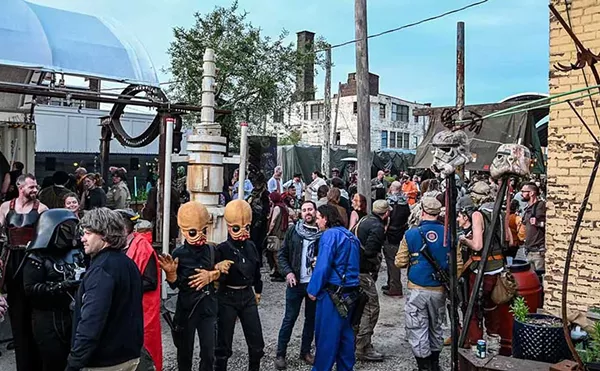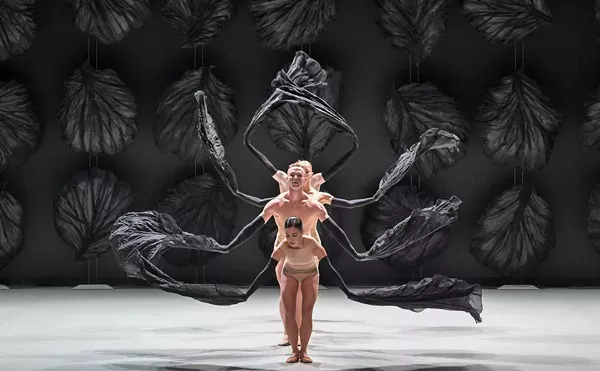
Audio By Carbonatix
[
{
"name": "GPT - Leaderboard - Inline - Content",
"component": "35519556",
"insertPoint": "5th",
"startingPoint": "3",
"requiredCountToDisplay": "3",
"maxInsertions": 100,
"adList": [
{
"adPreset": "LeaderboardInline"
}
]
}
]
After a lukewarm Der Rosenkavalier last month, Michigan Opera Theatre cranked up the heat several notches for its passionate – indeed, fiery – production of Tosca last Saturday.
As popular as this opera is, it’s seldom presented well. If there’s a weak link among the three leads, the dramatic cohesion is torn asunder. Some operas can slide by on voices alone, but Tosca demands intense acting. So it’s a pleasure to report that MOT’s Tosca is not only up to snuff, it’s one of the company’s finest achievements in recent memory.
Everyone knows top-drawer tenors are a rarity today. That’s why we are subjected to extravaganzas by the creaky Three Tenors and an over-the-hill Carlo Bergonzi struggling through a concert version of Otello. Tenor devotees are willing to resort to desperate measures to hear vestiges of formerly great singers.
But there’s a tenor in our midst in peak form: Marcello Giordani, who takes on the role of the painter and political activist, Mario Cavaradossi. His robust, lyrical instrument was heard to advantage in MOT’s Manon a couple of seasons ago, but the role of Cavaradossi suits him even better. Giordani’s chest voice is a little weak, but his head voice is often thrilling. He has a distinctive ring in his upper notes, which the Italians call squillo, and it can send audiences airborne. When Giordani sang his first-act aria, "Recondita armonia," and sailed up to a red-blooded B-flat, he was answered by a chorus of bravos.
Despite occasional woodenness, Giordani loosens up when he shares the stage with his dynamic Tosca, soprano Marquita Lister, who is replacing an indisposed Sylvie Valayre. If Lister’s uppermost notes are sometimes squally, her cello-like chest and middle register are solid and provide a palette of rich colors. Equally important, Lister sinks her teeth into the role; she is, by turns, ardent, furious, jealous and pathetic. Her exchange with the Roman chief of police, Scarpia (Justino Diaz), is fraught with raw-boned emotion.
From the moment he appears, Diaz projects not mere venality, but a kind of wicked oiliness that he refines into calculated lechery, as he urges Tosca to submit to sex in exchange for the life of her imprisoned lover, Cavaradossi. Although it was announced that Diaz was battling allergies, problems were minimal. He has a big, orotund baritone, blemished only by a tad of raspiness.
Tony Walton’s sets are not only apt, but impressive, and lighting designer Kendall Smith deserves high marks for his nuanced work. In the first-act church scene, the light is appropriately filtered and dusky. In the final act, when Cavaradossi is executed at dawn, we see a rosy morning sky spread over the golden dome of St. Peter’s Basilica in the background.
Steven Mercurio proves dependable once again in the pit, coaxing the orchestra to play with a heady blend of lyricism and drama.
Director Mario Corradi is guilty of a couple of flubs. Why, for instance, does he have the sacristan act like such a ditsy buffoon? And the over-the-top church celebration resembles a playground at noon. Yet, Corradi is mostly on the mark, as is this entire production.
Giordani sings May 10 and 13 and alternates with Ian DeNolfo on May 12 and 14. Lister performs May 10 and 13, while Amy Johnson alternates May 12 and 14.
E-mail comments to letters@metrotimes.com




